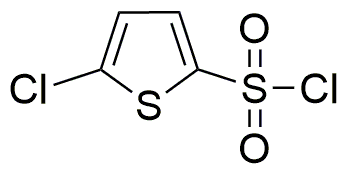5-Chloro-2-thiophenesulfonyl chloride is widely utilized in research focused on:
- Synthetic Chemistry: This compound serves as a key intermediate in the synthesis of various pharmaceuticals and agrochemicals, allowing researchers to create complex molecules efficiently.
- Drug Development: It is used in the development of sulfonamide-based drugs, which have applications in treating bacterial infections, showcasing its importance in medicinal chemistry.
- Material Science: The compound is employed in the production of functionalized polymers and materials, enhancing properties like conductivity and thermal stability in advanced materials.
- Organic Synthesis: It acts as a versatile reagent in organic synthesis, particularly in the formation of sulfonyl derivatives, which are valuable in various chemical reactions.
- Research Applications: In academic and industrial laboratories, it is utilized for studying reaction mechanisms and developing new synthetic methodologies, providing insights into chemical behavior.
General Information
Properties
Safety and Regulations
Applications
5-Chloro-2-thiophenesulfonyl chloride is widely utilized in research focused on:
- Synthetic Chemistry: This compound serves as a key intermediate in the synthesis of various pharmaceuticals and agrochemicals, allowing researchers to create complex molecules efficiently.
- Drug Development: It is used in the development of sulfonamide-based drugs, which have applications in treating bacterial infections, showcasing its importance in medicinal chemistry.
- Material Science: The compound is employed in the production of functionalized polymers and materials, enhancing properties like conductivity and thermal stability in advanced materials.
- Organic Synthesis: It acts as a versatile reagent in organic synthesis, particularly in the formation of sulfonyl derivatives, which are valuable in various chemical reactions.
- Research Applications: In academic and industrial laboratories, it is utilized for studying reaction mechanisms and developing new synthetic methodologies, providing insights into chemical behavior.
Documents
Safety Data Sheets (SDS)
The SDS provides comprehensive safety information on handling, storage, and disposal of the product.
Product Specification (PS)
The PS provides a comprehensive breakdown of the product’s properties, including chemical composition, physical state, purity, and storage requirements. It also details acceptable quality ranges and the product's intended applications.
Certificates of Analysis (COA)
Search for Certificates of Analysis (COA) by entering the products Lot Number. Lot and Batch Numbers can be found on a product’s label following the words ‘Lot’ or ‘Batch’.
*Catalog Number
*Lot Number
Certificates Of Origin (COO)
This COO confirms the country where the product was manufactured, and also details the materials and components used in it and whether it is derived from natural, synthetic, or other specific sources. This certificate may be required for customs, trade, and regulatory compliance.
*Catalog Number
*Lot Number
Safety Data Sheets (SDS)
The SDS provides comprehensive safety information on handling, storage, and disposal of the product.
DownloadProduct Specification (PS)
The PS provides a comprehensive breakdown of the product’s properties, including chemical composition, physical state, purity, and storage requirements. It also details acceptable quality ranges and the product's intended applications.
DownloadCertificates of Analysis (COA)
Search for Certificates of Analysis (COA) by entering the products Lot Number. Lot and Batch Numbers can be found on a product’s label following the words ‘Lot’ or ‘Batch’.
*Catalog Number
*Lot Number
Certificates Of Origin (COO)
This COO confirms the country where the product was manufactured, and also details the materials and components used in it and whether it is derived from natural, synthetic, or other specific sources. This certificate may be required for customs, trade, and regulatory compliance.


